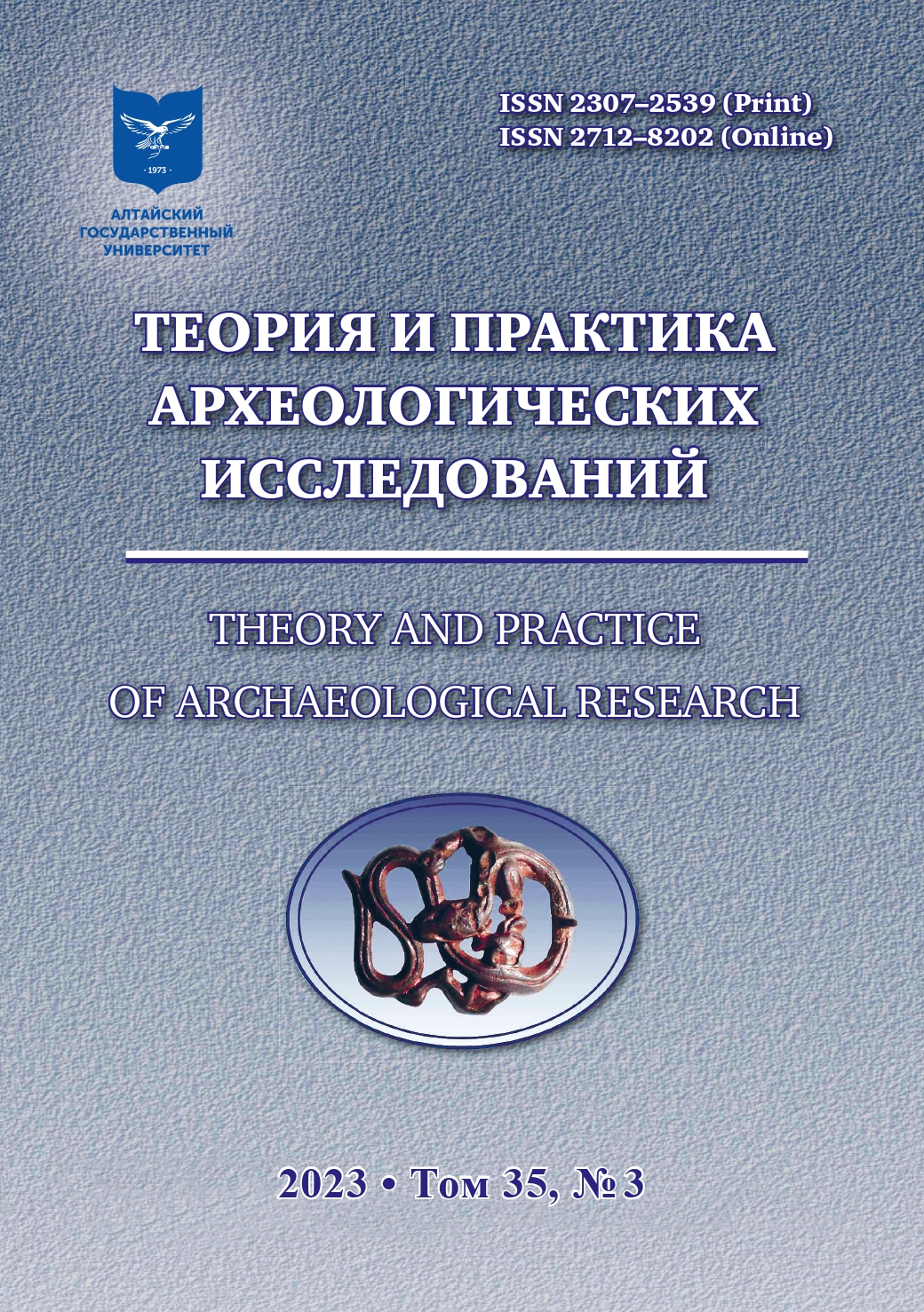НАУЧНЫЙ АНАЛИЗ ФИОЛЕТОВОГО ВОСЬМИУГОЛЬНОГО СТОЛБЧАТОГО ИЗДЕЛИЯ, НАЙДЕННОГО НА МОГИЛЬНИКЕ ХЭЦЗЯ, СЯНЬЯН, ШЭНЬСИ, И СВЯЗАННЫЕ С ЭТИМ ВОПРОСЫ
Аннотация
В данной работе в качестве объекта исследования выбрано фиолетовое восьмиугольное призматическое изделие периода поздней войны, найденное на могильнике Хэцзя в Сяньяне, и проведен научный анализ с использованием методов сверхглубокой полевой микроскопии, сканирующей электронной микроскопии и анализа энергетического спектра, рентгеновской дифракции и микроскопической рамановской спектроскопии. В первую очередь были определены особенности формирования и процесса выветривания, затем исследованы образцы невыветрившихся участков, полученные методом секционирования, и подтверждено, что все 12 образцов представляют собой силикат меди бария с основными фазами китайского фиолетового (BaCuSi2O6) и китайского темно-синего (BaCu2Si2O7) цвета. На основании композиционных характеристик было также установлено, что данная группа фиолетовых восьмиугольных изделий воплощает два различных производственных процесса и может представлять собой эволюцию процесса от свинцово-бариевого стекла к медно-бариевому силикату. На этой основе обсуждаются такие вопросы, как популяция, ареал распространения и функциональные характеристики данного типа изделий с целью получения новых идей и доказательств для соответствующих исследований.
Скачивания
Литература
Bai Yu. Archaeological Study of the Golden Banded Hook. Heritage World. 2021;8.
Elisabeth W.F., Lynda A.Z. A Purple Barium Copper Silicate Pigment from Early China. Studies in Conservation. 1992;37(3):145.
Elisabeth W.F., Lynda A.Z. An Early Man-Made Blue Pigment from China : Barium Cop per Silicate. Studies in Conservation. 1983;28(1):15.
Gan Fuxi et al. Scientific and Technological Analysis and Research of Warring States Glass ware RRxcavated in Hubei Province. Jianghan Archaeology. 2010;2.
Gansu Provincial Museum: “Study on Synthetic Chinese Blue and Chinese Violet from the Warring States and Qin-Han periods”. Chinese Cultural Heritage. 2004;3.
Han Feng et al. Analytical Study of gGassware from the Warring States, Qin and Han Dynasties Excavated from Xinfeng Cemetery, Lintong, Shaanxi. Spectroscopy and Spectral Analysis. 2017;5.
Hou Xiaonan. Research on the Burial Jades in the Tombs of Han Dynasty Nobles in Shandong: Master’s Thesis. Yunnan University, 2021. P. 35.
Huang Jibo. C1M3943 Warring States Tomb in Xigong District, Luoyang City. Cultural Relics. 1999;8.
Huang Xiaojuan et al. Analytical Study of Glass and Han Purple Six Bo Chess Pieces Excavated from Warring States. In: Qin and Han Dynasties Tombs. Shaanxi. Spectroscopy and Spectral Analysis, 2022. No.10.
Huang Xiaojuan et al. Analytical Study on Silicate Type Decorative Beads Excavated from Zaitouhe Cemetery, Shaanxi Province. Archaeology and Cultural Relics. 2018.
Li Qinghui et al. Several Issues on the Study of Ancient Chinese Glass. Studies in the History of Natural Sciences. 2007;2.
Lin Yixian et al. Research on Glass and Related Materials Excavated from the Warring States Cemetery of Majia Plateau, Zhangjiachuan. Cultural Relics. 2018;3.
Lin Yixian et al. Study on Glass and Related Materials Excavated from the Warring States Cemetery of Majia Plateau, Zhangjiachuan. Cultural Relics. 2018;3.
Ma Qinglin et al. A Study of Simulation of the Production Technology of Ancient Chinese Blue and Purple Faience During the Warring States. Qin and Han Dynasties, Recent Advances in the Scientific Research in Ancient Glass and Glaze. 2016:499–514.
Ma Qinglin et al. A Study on the Composition and Structure of Octagonal Faience Products from the Warring States Period in China. Journal of the National Museum of China. 2012;12.
Ma Qinglin, et al. A Study of Chinese Blue and Chinese Purple in the Octagonal Pillars Excavated from the Warring States Tomb at Luoyang. Cultural Relics. 2008;8.
Ma Qinglin, et al. Raman and SEM Studies of Man-Made Barium Copper Silicate Pigments in Ancient Chinese. Studies in Conservation. 2006;51(2):82.
Ma Qinglin, et al. Study on the Composition and Structure of Octagonal Faience Products from the Warring States Period of China. Journal of the National Museum of China. 2012;12.
Shaanxi Provincial Institute of Archaeology, He Bei Cemetery, Xianyang, in Archaeological Annual 2021 (internal source). Shaanxi Provincial Institute of Archaeology, 2021.
Sun Feng et al. Archaeological Observations on Octagonal Artifacts from the Warring States to Han Dynasties. Sichuan Cultural Relics. 2020;6.
Teng Mingyu. On the Straight-Limbed Burials in Qin Tombs and Related Issues. Cultural Relics Quarterly. 1997;1.
Wang Ruosu et al. Study on the Composition and Weathering Layer of a Material Bead Excavated from M21 of Majiar Plateau. Spectroscopy and Spectral Analysis. 2022;10.
Wang Ruosu et al. Study on the Composition and Weathering Layer of a Material Bead Excavated from M21 of Majia Plateau. Spectroscopy and Spectral Analysis. 2022;10.
Wang Yingzhu. A Study of Feiangsi Technology in the Two-Week Period: Ph.D. dissertation. University of Science and Technology Beijing, 2019.
Wang Yingzhu. Research on the Feionce Technology in the Two-Week Period: PhD thesis. Beijing : University of Science and Technology, 2019.
Xu Huipan. Research on the Regulatory Behavior of Lead Salt Additives in the Solid Sintered Chinese Purple Process: Master’s Thesis. Northwestern University, 2020.
Xu Huipan. Study on the Regulatory Behavior of Lead Salt Additives in the Solid Sintering of Chinese Violet”: M.S. Thesis. Northwestern University, 2020.
Xu Lin. From the Han Jade to the Two Han Dynasties of the Immortal Longevity Thought. Journal of the Palace Museum. 2008;1.
Yan Long et al. On the Origin, Development and Evolution of the Doctrine of the Five Elements. Journal of Beijing University of Traditional Chinese Medicine. 2016;9.
Yan Qingqing. Study on the Thermal Stability of the Ancient Chinese Man-made Pigment Copper Barium Silicate: Master’s Thesis. Northwestern University, 2022.
Yu Jing et al. Excavation Report on the Ancient City Site of Erlonghu, Siping City, Jilin Province. Frontier Archaeological Research. 2012;2.
Zhang Mengyuan. The Origin Function of Cocoon Shaped Pots and Their Spread with the Qin. Yanhuang Geography. 2021;3.
Copyright (c) 2023 Ф. Сунь

Это произведение доступно по лицензии Creative Commons «Attribution» («Атрибуция») 4.0 Всемирная.
Авторы, публикующиеся в данном журнале, соглашаются со следующими условиями:
a. Авторы сохраняют за собой права на авторство своей работы и предоставляют журналу право первой публикации этой работы с правом после публикации распространять работу на условиях лицензии Creative Commons Attribution License, которая позволяет другим лицам свободно распространять опубликованную работу с обязательной ссылокой на авторов оригинальной работы и оригинальную публикацию в этом журнале.
b. Авторы сохраняют право заключать отдельные договора на неэксклюзивное распространение работы в том виде, в котором она была опубликована этим журналом (например, размещать работу в электронном архиве учреждения или публиковать в составе монографии), с условием сохраниения ссылки на оригинальную публикацию в этом журнале. с. Политика журнала разрешает и поощряет размещение авторами в сети Интернет (например в институтском хранилище или на персональном сайте) рукописи работы как до ее подачи в редакцию, так и во время ее редакционной обработки, так как это способствует продуктивной научной дискуссии и положительно сказывается на оперативности и динамике цитирования статьи







2.jpg)






